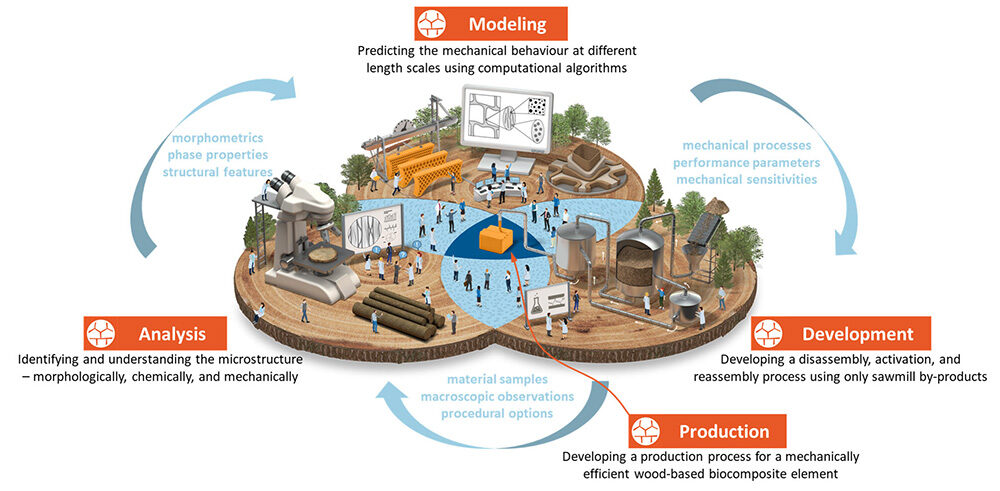The Christian Doppler Laboratory for Next-Generation Wood-Based Biocomposite (WoodComp3D) develops processes for the production and characterization of sustainable biocomposite materials based on sawmill by-products.
Wood as a sustainable building material – Unused potential
One of the greatest challenges of the 21st century will be using more sustainable building materials on a larger scale, as the current trend towards more timber constructions already suggests. The value chain of wood products starts in sawmills, where logs are sawn into wooden lamellas, the basic elements for modern structural wood-based products, which not only generate immense added value but store a significant amount of carbon dioxide. However, the mean lumber yield in sawing is only about 50 % and becomes even less in further processing steps up to the finished construction. Thus, the greater part of this valuable raw material is fed to low-value chains and even burned to a large extent. Meaning that the ingenious lightweight structure, developed by nature over thousands of years to efficiently carry heavy loads and still present in these millimeter-sized sawmill by-products, is forever destroyed, and the carbon dioxide bound in them is released into the atmosphere.
Our vision for this CD lab
Imagine, these outstanding structural building blocks could be reassembled into macroscopic load-bearing structures in a sustainable way and, thus, raised to a similar value-added level as the products in which production process they were generated. The yield of sustainable load-bearing structures could be doubled immediately without using additional natural resources.
We disassemble these by-products as little as necessary through thermo-chemical-mechanical pretreatment and a gentle extraction process of lignin, hemicellulose, and extractives. Only with an intensity required to obtain individual and highly reactive fibers that can be reassembled using binding materials which are available in the same raw material, like lignin or extractives. This means the underlying philosophy is to destroy the microstructure of wood as little as possible and preserve existing features that have already been optimized by nature, such as the high-strength nanostructure of wood fibers. The remaining lignocellulosic network can then be bonded together in a molding or even additive manufacturing process.
How can this vision be implemented?
To achieve this research goal, we use a chemistry-based and simulation-guided development strategy, which needs an interdisciplinary approach with fundamental research in multiple fields. Process engineering, material chemistry, chemical engineering, and material as well as mechanical engineering must work together in close interaction. Through novel pretreatments, we aim to obtain fiber material with tunable composition on the one hand and extracted components with crosslinking ability on the other hand. These are then combined into a homogeneous processable mixture using approaches like fiber swelling, impregnation, and additive precipitation, to stimulate the formation of covalent bonds.
Innovative microscopic and spectroscopic techniques (e.g., NMR, Raman, fluorescence) are used in a new interaction to identify the type and location of the bonds achieved, and the biocomposite is described mechanically on different length scales with advanced concepts of continuum micromechanics and finite element-based fracture mechanics, including new methodological developments specifically for such materials. Only in this way will we gain a fundamental understanding of all underlying mechanisms. A simulation- and information-driven targeted material development is thereby made possible and will enable the creation of a next-generation biocomposite and its subsequent application in advanced manufacturing methods.
Environmental and economic impact
The proposed engineering-driven approach to deal with biocomposite materials will also allow the development of completely new products with complex geometries and demand-specific properties in an additive instead of subtractive manufacturing process, which would additionally contribute to a sustainable use of wood as a natural resource. Developments in the field of sustainable building materials, an area which is, and should remain, not only one of the core competencies of Austria but will also occupy the construction industry worldwide in this century.
During this research process, future experts in this field will be trained, long-term cooperation between science and industry will be initiated and established, and competence in an economically important industrial field will be created for Austria.

 WoodComp3D
WoodComp3D

